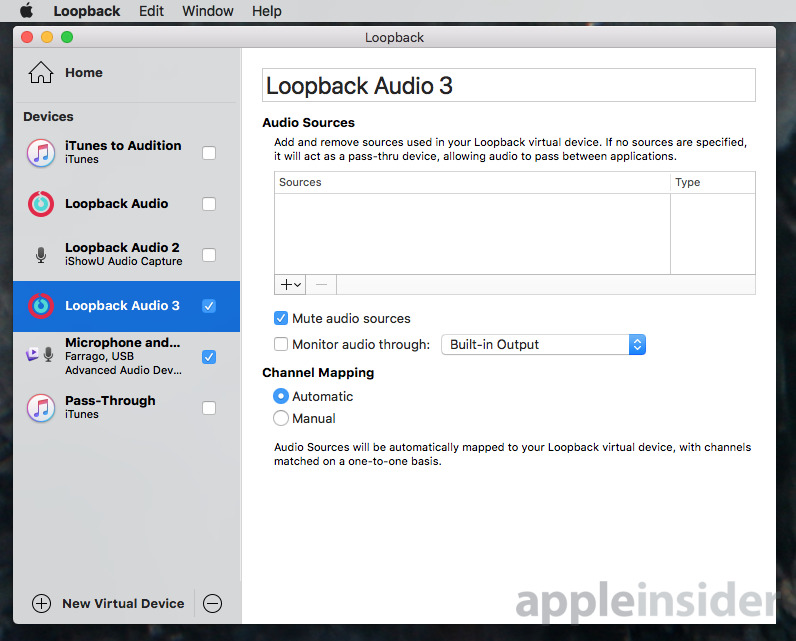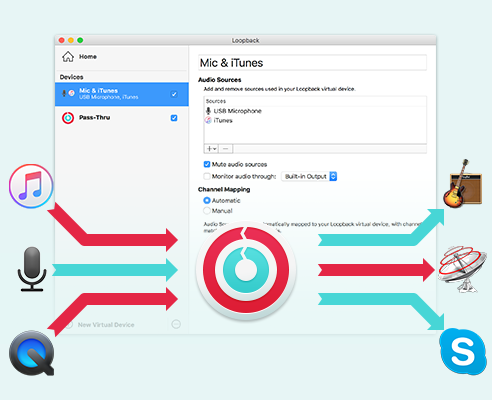
Then, set the “Input” bar to VB Cable, connecting spf.io to Zoom. Click the gear to open spf.io’s input-output menu. In upper left-hand area, near the language channel selector, is a small gear. Set the spf.io captioner’s input and output sources. Click on the correct language and then click on “Autopilot” so it is enabled.ģ. This should be in the upper left corner of the captioner screen. Select the channel of the spoken language in the meeting. If your browser asks for microphone access, click “Allow.”Ģ. Then, open it by clicking Control as Operator. Set up spf.io as you normally would for either raw captioning or auto-caption and translate. Log into spf.io and create a new session.
#RECORD MAC AUDIO LOOPBACK MAC#
The computer set up to auto-caption the Zoom meeting must be a separate device from the one that you yourself will use to participate in the Zoom meeting.įor both Mac and PC: Within-spf.io Setup | Zoom Setupġ. IMPORTANT NOTE: If you also need to speak in the call, you need two devices. Here are the steps to set up and loopback audio of a Zoom call. Below is a diagram explaining how it works (this applies to OBS as well). This routes the sound into spf.io to generate captions. In order to caption multiple speakers on the Zoom call, you will need to loopback audio from your meeting.

You do not have someone to manually caption your meetingĪs you prepare to use this feature, make sure that you:.Multiple people on the same Zoom call will be speaking.You are an event organizer supporting a Zoom meeting for a client.This loopback audio method is useful where: The rest of this article is for reference if local loopback is still required. Follow these instructions to set that up. Note: spf.io recently added support for “Cloud Loopback” which greatly simplifies getting loopback audio by not requiring installation of any additional software. This will allow you to provide automatic captioning on Zoom calls yourself. In this article, we’ll go over how “loopback” your audio. You can set Pages to optimize the format and quality of movies and images that you add to documents.Automatic captioning for your Zoom calls is a convenient way to enhance your meeting. To work with multiple videos or audio objects at the same time, hold down the Shift key while you click the objects. Control-click the recording, choose Share Recording, then choose a method to send it. You can also share your recording as an audio file. To delete the recording, click to select it, then press Delete. To edit the recording after you add it to a page, click to select it, then click Edit Recording in the Audio tab of the Format sidebar. To play your recording on the page, click.

On the page where you want to add the recording, click Insert or Save, then drag the to position the audio anywhere in the document. Click to delete everything inside the handles. Click to delete everything outside the handles.ĭelete all or part of the recording: Drag the orange handles to define the section you want to delete. Trim: Drag the orange handles to define the section you want to keep. Rerecord a section: Drag the blue handles to select the section. To edit your recording, click Edit, then do any of the following: To play from a specific point, position your pointer over the recording, swipe left or right to position the black line (or drag the scroll bar), then click Preview. To preview your recording, click Preview. While you record, you can continue editing your document. To rerecord from a specific point, position your pointer over the recording, swipe left or right to position the black line (or drag the scroll bar), then click. To begin recording, click to stop recording, click. Note: After you record, you insert the recording wherever you want in the document.

Bold, italic, underline, and strikethrough.Select text and place the insertion point.Use VoiceOver to preview comments and track changes.View formatting symbols and layout guides.Intro to images, charts, and other objects.


 0 kommentar(er)
0 kommentar(er)
